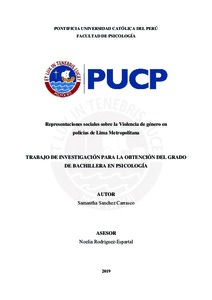Representaciones sociales sobre la violencia de género en policías de Lima Metropolitana
Abstract
La presente investigación tuvo como objetivo acercarse a las representaciones sociales (RS)
sobre la violencia de género (VdG) en agentes activos, hombres y mujeres, de la Policía
Nacional del Perú. Todo ello, con el propósito de comprender cómo construyen los conceptos
de violencia y género; así como explorar cómo se establecen las interacciones entre víctimas,
victimarios y los agentes de la PNP. Las técnicas que permitieron conocer al grupo de
participantes y la forma en que se construyen las RS fueron las entrevistas semi-estructuradas
y la ficha de datos sociodemográficos. De manera general, se encontró una concepción de
violencia como parte de la realidad, aprendida a partir de la socialización temprana y VdG
desde la visión dicotómica del concepto, femenino y masculino, reconociendo como principal
agresor al varón y como principal víctima, a la mujer. Por otro lado, se manifestó un doble
discurso, en el que la población LGBTIQ+ se muestra vulnerada únicamente desde la
discriminación, pero con casos de violencia física justificados como confusión a partir de la
expresión de género de la víctima. Además, se explica que el trato a la población LGBTIQ+
podría ser discriminatorio debido a la presencia de los roles tradicionales de género propios de
la institución policial, expresada desde la hetero-cis-normatividad. The aim of this research was to approach social representations (SR) of gender based violence
(GBV) in active agents of the National Police of Peru. All of it, with the purpose of
understanding how they construct the concepts of violence and gender; as well as exploring
how the interactions between victims, victimizers and police agents are established. The
techniques that allowed to know the group of participants and the way in which the social
representations were constructed were the semi-structured interviews and the
sociodemographic data sheet. In general, the concept of violence was found as part of the
reality, learned from early socialization and gender based violence from the dichotomous vision
of the concept, feminine and masculine, recognizing the male as the main aggressor and the
woman as the main victim. On the other hand, a double discourse was manifested, in which the
LGBTIQ+ population appears to be violated only from discrimination, but with cases of
physical violence justified as confusion based on the gender expression of the victim. In
addition, it is explained that the treatment of the LGBTIQ+ population could be discriminatory
due to the presence of the traditional gender roles in the police institution, expressed from the
hetero-cis-normativity.
Temas
Representaciones sociales
Violencia contra la mujer
Género
Policía Nacional--Perú
Heterosexismo
Violencia contra la mujer
Género
Policía Nacional--Perú
Heterosexismo
Para optar el título de
Bachiller en Psicología
Collections
The following license files are associated with this item:






